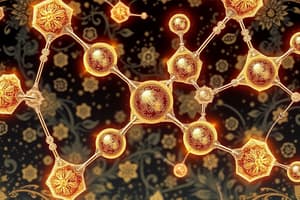Podcast
Questions and Answers
ما هو العنصر الأساسي المدروس في الكيمياء العضوية؟
ما هو العنصر الأساسي المدروس في الكيمياء العضوية؟
- النيتروجين
- الأكسجين
- الهيدروجين
- الكربون (correct)
ما هو أحد العناصر التي يمكن أن تحتويها المركبات في دراسة الكيمياء العضوية؟
ما هو أحد العناصر التي يمكن أن تحتويها المركبات في دراسة الكيمياء العضوية؟
- الليثيوم
- الفضة
- البروم (correct)
- الأوزون
ما هي مجالات دراسة الكيمياء العضوية؟
ما هي مجالات دراسة الكيمياء العضوية؟
- دراسة التفاعلات النووية
- دراسة خصائص وتفاعلات المركبات المستندة إلى الكربون (correct)
- دراسة الخواص الفيزيائية للغازات
- دراسة خصائص المعادن
ما هي الصيغة العامة للألكانات؟
ما هي الصيغة العامة للألكانات؟
ما نوع الروابط المتشكلة بين ذرات الكربون في الجزيئات العضوية؟
ما نوع الروابط المتشكلة بين ذرات الكربون في الجزيئات العضوية؟
ماذا يطلق على مجموعات الذرات التي تمنح الجزيئات العضوية خصائص محددة؟
ماذا يطلق على مجموعات الذرات التي تمنح الجزيئات العضوية خصائص محددة؟
ما هو النظام الذي يستخدم لتسمية المركبات العضوية؟
ما هو النظام الذي يستخدم لتسمية المركبات العضوية؟
ما هي خصائص المركبات العضوية؟
ما هي خصائص المركبات العضوية؟
ما هي التفاعلات التي تشتمل عليها الكيمياء العضوية؟
ما هي التفاعلات التي تشتمل عليها الكيمياء العضوية؟
ما هو التشابه بين المركبات المختلفة؟
ما هو التشابه بين المركبات المختلفة؟
Study Notes
Introduction to Organic Chemistry
Organic chemistry is the scientific study of the structure, properties, composition, reactions, and preparation of carbon-based compounds, hydrocarbons, and their derivatives. These compounds may contain any number of other elements, including hydrogen, nitrogen, oxygen, the halogens, phosphorus, silicon, and sulfur. The field of organic chemistry encompasses a wide range of topics, including:
- Structure and bonding
- Resonance and acid-base chemistry
- Alkanes, cycloalkanes, and functional groups
- Naming alkanes, cycloalkanes, and bicyclic compounds
- Conformations of alkanes, cycloalkanes, and functional groups
- Free radical reactions: substitution and elimination reactions
- Nucleophilicity and basicity
- Synthesis and properties of alcohols, ethers, epoxides, sulfides, and carboxylic acids
- Aromatic compounds, their nomenclature, and reactions
- Biocatalysis, catalysis, chemosensors, chiral synthesis, flow chemistry, green chemistry, mechanochemistry, and photoredox catalysis
Structure and Bonding
Organic compounds are built from covalent bonds between carbon atoms and other elements. The bonding in organic molecules can be described using Lewis structures, which show the atoms and bonds in a molecule. Organic molecules can also form resonance structures, which are multiple possible bonding arrangements that contribute to the stability of the molecule.
Types of Organic Compounds
Organic chemistry deals with various types of organic compounds, including:
- Alkanes: Straight-chain or branched hydrocarbons with the general formula C_nH_2n+1.
- Cycloalkanes: Hydrocarbons with a ring structure, such as cyclopropane, cyclobutane, and cyclopentane.
- Functional Groups: Atom or groups of atoms that impart specific properties to a compound, such as alcohols, carboxylic acids, and alkynes.
Nomenclature and Properties
Organic compounds are named using the International Union of Pure and Applied Chemistry (IUPAC) nomenclature system, which provides a standardized naming procedure for organic compounds. The properties of organic compounds can be diverse, ranging from physical properties like boiling points and solubility to chemical properties like reactivity and stability.
Reactions in Organic Chemistry
Organic chemistry involves various types of reactions, such as:
- Nucleophilic Substitution Reactions (SN1 and SN2): Reactions in which a nucleophile replaces a leaving group on an electrophile.
- Elimination Reactions (E1 and E2): Reactions in which a molecule loses a molecule of HCl or HBr, usually involving alkenes or alkynes.
- Addition Reactions: Reactions in which two or more molecules combine to form a new molecule, such as the addition of hydrogen, bromine, or water across a carbon-to-carbon double bond.
Stereochemistry and Isomerism
Stereochemistry is the study of the three-dimensional configuration of organic molecules. Isomers are molecules that have the same chemical formula but different three-dimensional shapes, such as cis-trans isomers. The stereochemistry of organic molecules can be predicted using Fischer projections, Newman projections, and conformational analysis.
Conclusion
Organic chemistry is a vast field that encompasses the study of structure, properties, composition, reactions, and preparation of carbon-based compounds and their derivatives. This article provides an overview of the key concepts and subtopics in organic chemistry, including structure and bonding, types of organic compounds, nomenclature and properties, reactions, and stereochemistry. Further exploration of these topics can lead to a deeper understanding of the complex world of organic chemistry.
Studying That Suits You
Use AI to generate personalized quizzes and flashcards to suit your learning preferences.
Description
Test your knowledge of organic chemistry with this quiz covering key concepts including structure and bonding, types of organic compounds, nomenclature and properties, reactions, and stereochemistry. Explore the fundamentals of organic chemistry through a series of challenging questions.




